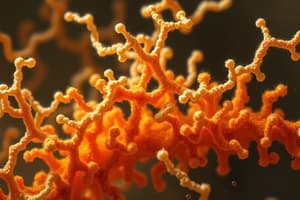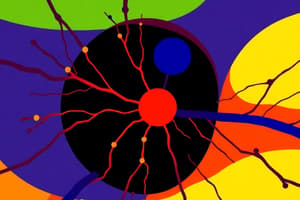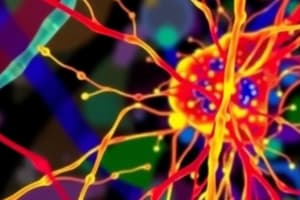Podcast
Questions and Answers
What are the major structural elements of the cytoskeleton?
What are the major structural elements of the cytoskeleton?
- Microfilaments, microtubules, intermediate filaments (correct)
- Ribosomes, endoplasmic reticulum, Golgi apparatus
- Lysosomes, peroxisomes, vacuoles
- Chloroplasts, mitochondria, nucleus
What are the functions of the cytoskeleton?
What are the functions of the cytoskeleton?
- Cell movement and division (correct)
- DNA replication and repair
- Protein synthesis and packaging
- Energy production and storage
What are the bacterial cytoskeletal elements structurally similar to those in eukaryotes?
What are the bacterial cytoskeletal elements structurally similar to those in eukaryotes?
- Peptidoglycan and lipopolysaccharides
- Actin-like MreB and tubulin-like FtsZ (correct)
- Chlorophyll and carotenoids
- Nucleoid and plasmids
Which proteins use ATP to drive vesicle or organelle transport or to generate sliding forces between microtubules?
Which proteins use ATP to drive vesicle or organelle transport or to generate sliding forces between microtubules?
Which proteins bind at regular intervals along a microtubule wall, allowing for interaction with other cellular structures and filaments?
Which proteins bind at regular intervals along a microtubule wall, allowing for interaction with other cellular structures and filaments?
Which proteins promote depolarization of microtubules?
Which proteins promote depolarization of microtubules?
Which proteins bind to tubulin heterodimers and prevent their polymerization?
Which proteins bind to tubulin heterodimers and prevent their polymerization?
What gives microtubules inherent polarity with plus and minus ends?
What gives microtubules inherent polarity with plus and minus ends?
What contributes to the dynamic instability of microtubules, leading to periods of growth, shrinkage, catastrophe, and rescue?
What contributes to the dynamic instability of microtubules, leading to periods of growth, shrinkage, catastrophe, and rescue?
What nucleates the assembly of new microtubules?
What nucleates the assembly of new microtubules?
Flashcards are hidden until you start studying
Study Notes
Microtubules: Structure, Assembly, and Function
- Microtubules are the largest structural elements of the cytoskeleton, involved in various cellular functions.
- There are two types of microtubules: cytoplasmic and nuclear, responsible for different functions such as maintaining axons and cell shape, and forming spindles.
- Microtubules are composed of tubulin heterodimers, forming straight, hollow cylinders of varied lengths.
- Protofilaments, made of α and β tubulin heterodimers, give microtubules inherent polarity with plus and minus ends.
- Microtubules form through the reversible polymerization of tubulin dimers in the presence of GTP and Mg2+, with distinct lag and elongation phases.
- Microtubule assembly depends on the concentration of tubulin dimers and the critical concentration, leading to growth or disassembly.
- The plus end of microtubules grows faster due to the addition of tubulin dimers, while treadmilling occurs when free tubulin concentration varies at the plus and minus ends.
- GTP hydrolysis contributes to the dynamic instability of microtubules, leading to periods of growth, shrinkage, catastrophe, and rescue.
- Microtubules originate from microtubule-organizing centers (MTOCs) containing γ-tubulin, which nucleates the assembly of new microtubules.
- MTOCs organize and polarize microtubules within cells, with the minus ends anchored in the MTOC, leading to dynamic growth and shrinkage at the plus ends.
- Centrosomes, containing γ-tubulin ring complexes, are MTOCs that nucleate the assembly of new microtubules away from the centrosome.
- Loss of γ-TuRCs prevents a cell from nucleating microtubules, impacting cellular functions.
Studying That Suits You
Use AI to generate personalized quizzes and flashcards to suit your learning preferences.




